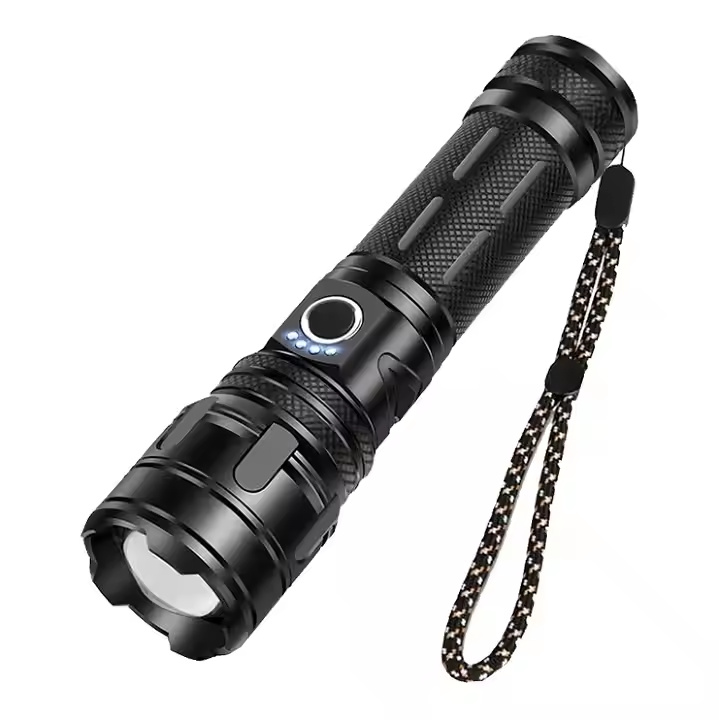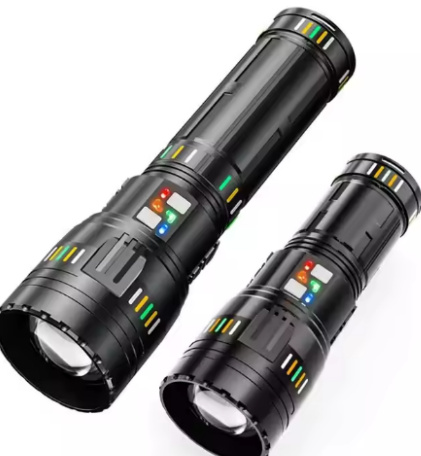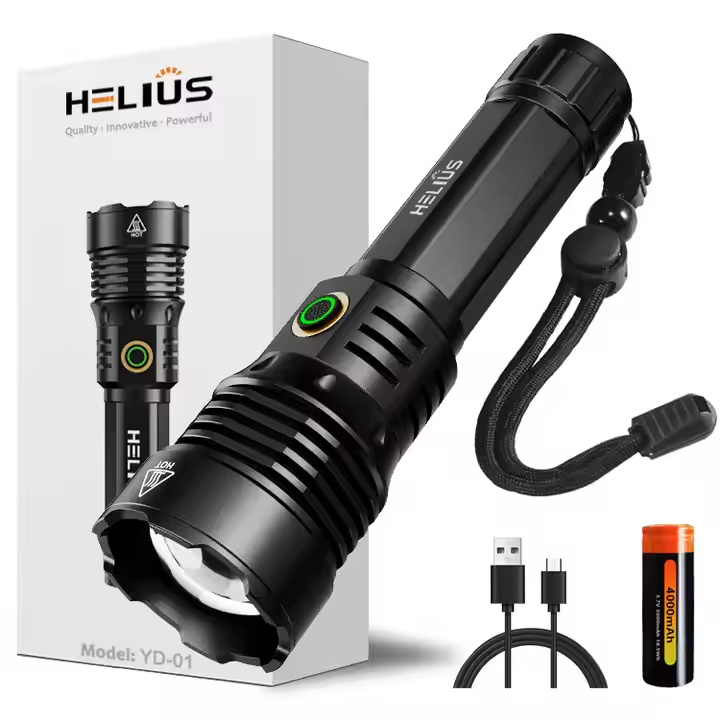Why Flashlight Supply Chain Efficiency Can Lead to Faster Time-to-Market

You rely on an efficient supply chain to bring flashlights to market quickly. Streamlining processes ensures fewer delays and smoother operations. Efficient supply purchasing reduces production bottlenecks, helping you save time and resources. When every step in the supply chain works seamlessly, you can deliver products faster and meet customer expectations. This is why flashlight supply chain efficiency can lead to faster time-to-market. By focusing on optimization, you gain a competitive edge and improve overall performance.
Key Takeaways
Make your supply chain simpler to avoid delays and work better. This helps you sell flashlights faster and keep customers happy.
Use tools to see your inventory in real-time. This helps track stock, avoid running out, and make better choices.
Use smart tools to predict inventory needs. Good guesses keep enough stock and stop waste.
Build strong relationships with suppliers and delivery companies. Trustworthy partners bring materials on time and move goods faster.
Use AI and machines to work smarter. These tools make tasks easier, fix mistakes, and help you react quickly to changes.
Challenges in Flashlight Supply Chains

Delays in Procurement and Manufacturing
Delays in procurement and manufacturing can disrupt your entire supply chain. When suppliers fail to deliver raw materials on time, production schedules get pushed back. This creates a ripple effect, delaying the assembly and delivery of flashlights to customers. Poor coordination between suppliers and manufacturers often leads to these setbacks. Additionally, unexpected issues like equipment breakdowns or labor shortages can further slow down production. Addressing these delays requires proactive planning and strong communication with your suppliers.
Inefficient Inventory Management
Inefficient inventory management can result in stock shortages or overstocking. Both scenarios hurt your business. Stock shortages prevent you from meeting customer demand, while overstocking ties up capital and increases storage costs. Without a clear system to track inventory levels, you risk losing control over your supply chain. Implementing better inventory management practices ensures you maintain the right balance of stock. This helps you avoid disruptions and keeps your operations running smoothly.
Limited Real-Time Inventory Visibility
Limited real-time inventory visibility creates significant challenges in flashlight supply chains. Without accurate, up-to-date information, you struggle to make informed decisions.
The key causes of limited real-time inventory visibility in flashlight supply chains include fragmented systems, inefficient communication and human error, and legacy technologies.
Several factors contribute to this issue:
Fragmented systems create data silos that hinder the seamless flow of information across the supply chain.
Inefficient communication and human error lead to gaps in visibility and operational challenges.
Legacy technologies impact the real-time exchange of data, as they often lack the capabilities needed for modern supply chains.
Improving visibility requires integrating advanced tools and technologies. This allows you to monitor inventory levels in real time, reducing the risk of stock shortages and ensuring timely deliveries.
Why Flashlight Supply Chain Efficiency Can Lead to Faster Time-to-Market
Faster Production and Delivery Cycles
Improving supply chain efficiency directly accelerates production and delivery cycles. Practices like just-in-time inventory management reduce lead times by ensuring materials arrive only when needed. This eliminates delays caused by excess or insufficient stock. Automation further enhances production speed by streamlining manufacturing processes. For example, automated systems can handle repetitive tasks faster than manual labor, allowing you to meet tight deadlines.
Efficient production processes also improve order fulfillment. By minimizing lead times, you can deliver products to customers more quickly. Customer order cycle time becomes a key metric to track how fast you fulfill orders. When you optimize these cycles, you not only save time but also enhance your ability to respond to market demands.
Practice | Impact on Production and Delivery Cycles |
|---|---|
Just-In-Time Inventory Management | Reduces lead times by ordering inventory only when needed, speeding up production. |
Automation | Enhances efficiency in production processes, leading to faster manufacturing times. |
Cost Optimization and Resource Management
Streamlining your supply chain helps you balance cost reduction with maintaining product quality. Identifying cost factors like material quality and design complexity allows you to make informed decisions. Scaling production lowers unit costs through economies of scale, while process optimization reduces waste and inefficiencies.
Innovative technologies like 3D printing and digital twins improve production efficiency. These tools allow you to create prototypes faster and refine designs without incurring high costs. Strategic sourcing also plays a role in cost management. By partnering with reliable suppliers, you can secure high-quality materials at competitive prices. This ensures you maintain product standards while keeping expenses under control.
Enhanced Customer Responsiveness
An efficient supply chain enables you to respond quickly to customer needs. Faster delivery times and reliable service improve customer satisfaction. Studies show that 96% of customers consider service quality crucial to their loyalty. Businesses with excellent customer experiences outperform competitors and achieve higher profits.
Loyal customers are more likely to buy again and recommend your brand to others. They are also willing to pay more for products from companies known for great service. By prioritizing customer responsiveness, you strengthen your reputation and build long-term relationships. This not only boosts sales but also enhances your competitive edge in the flashlight market.
Tip: Improving customer responsiveness doesn’t just benefit your business—it also fosters trust and loyalty among your audience.
Strategies to Improve Supply Chain Efficiency

Leverage Real-Time Inventory Visibility
Real-time inventory visibility plays a crucial role in improving supply chain efficiency. It allows you to anticipate and address potential issues before they escalate. For example, visibility platforms can alert you to transportation delays or low inventory levels, enabling proactive management. This reduces disruptions and ensures smoother operations.
With real-time insights, you can streamline logistics processes and cut transportation costs. Accurate visibility also enhances order accuracy, which improves customer satisfaction. Monitoring demand patterns helps you avoid overstocking or understocking, optimizing your resource allocation. Additionally, better communication through visibility tools fosters collaboration among stakeholders, ensuring everyone stays aligned.
By leveraging real-time inventory visibility, you gain control over your supply chain. This not only boosts efficiency but also strengthens your ability to meet customer expectations.
Optimize Inventory and Demand Forecasting
Effective inventory and demand forecasting ensures you maintain the right stock levels. Accurate forecasting helps you predict customer needs and adjust your inventory accordingly. This minimizes the risk of stock shortages or excess inventory, both of which can harm your business.
Using advanced tools like AI and machine learning improves forecasting accuracy. These technologies analyze historical data and market trends to provide actionable insights. For instance, they can identify seasonal demand patterns, allowing you to prepare in advance. Optimized forecasting also reduces waste and lowers storage costs, contributing to overall efficiency.
When you align inventory levels with demand, you create a more responsive supply chain. This ensures you can fulfill orders promptly and maintain customer trust.
Strengthen Supplier and Logistics Partnerships
Strong partnerships with suppliers and logistics providers are essential for an efficient supply chain. Reliable suppliers ensure timely delivery of materials, preventing production delays. Building trust with your suppliers encourages better communication and collaboration. This helps you address challenges quickly and maintain smooth operations.
Logistics providers play a key role in ensuring fast and cost-effective delivery. Partnering with experienced providers improves transportation efficiency and reduces shipping costs. Many companies are now adopting eco-friendly solutions to meet consumer demand and regulatory standards. Collaborating with partners who share these values enhances your brand reputation.
By strengthening these partnerships, you create a resilient supply chain. This positions your business for long-term success in the competitive flashlight market.
Integrate AI and Automation in Operations
Integrating AI and automation into your supply chain can transform operations and improve efficiency. These technologies streamline repetitive tasks, reduce errors, and enhance decision-making. By adopting AI-driven tools, you can optimize processes and achieve faster time-to-market.
AI-powered demand forecasting systems help you predict customer needs with greater accuracy. For example, the Danone Group implemented an AI-driven forecasting system that reduced workload by 50% and decreased forecasting errors by 20%. This system also eliminated 30% of revenue losses. Such advancements allow you to allocate resources effectively and avoid overproduction or stock shortages.
Automation addresses labor shortages by reallocating resources to boost productivity. In warehouses, robotic arms reduce human error and improve worker safety. AI algorithms enhance inventory management by predicting stock levels and ensuring you maintain optimal inventory. Freight management also benefits from AI, as it improves transportation decisions and reduces delivery delays.
Improvement Area | Impact Description |
|---|---|
Labor Shortages | Automation reallocates resources to boost productivity and efficiency. |
Warehouse Automation | Robotic arms reduce human error and improve worker safety. |
Inventory Management | AI uses predictive algorithms for effective stock level management. |
Freight Management | AI enhances decision-making in transportation management systems. |
Recent advancements in AI and automation are reshaping flashlight supply chains. Autonomous trucking optimizes route planning and improves transportation efficiency. AI demand predictions enable you to adjust shipment volumes based on market trends. Automating repetitive tasks helps you address labor shortages and maintain smooth operations.
Autonomous trucking optimizes route planning and transportation management systems.
AI demand predictions adjust shipment volumes based on market conditions.
Automation of repetitive tasks addresses labor shortages in the supply chain.
To fully leverage these technologies, focus on fostering collaboration with supply chain partners. Encourage continuous learning and prioritize employee development. These steps ensure your operations remain agile and resilient in a competitive market.
Measuring Supply Chain Efficiency
Key Metrics to Track Performance
Tracking the right metrics helps you evaluate your supply chain's efficiency. These metrics provide insights into areas that need improvement. Start by monitoring order accuracy. This metric measures how often you fulfill orders correctly without errors. High accuracy ensures customer satisfaction and reduces returns.
Another critical metric is inventory turnover. It shows how quickly you sell and replace stock. A high turnover rate indicates efficient inventory management. It also minimizes the risk of shortages or overstocking.
Delivery lead time is another key performance indicator. It measures the time taken from order placement to delivery. Shorter lead times reflect a streamlined supply chain. Monitoring this metric helps you identify delays and improve responsiveness.
Cost per order is equally important. It tracks the expenses incurred to process and deliver each order. Lowering this cost improves profitability without compromising quality.
Metric | What It Measures | Why It Matters |
|---|---|---|
Order Accuracy | Percentage of error-free orders | Enhances customer satisfaction |
Inventory Turnover | Frequency of stock replacement | Reduces shortages and overstocking |
Delivery Lead Time | Time from order placement to delivery | Improves responsiveness and efficiency |
Cost Per Order | Expenses per processed order | Boosts profitability |
Continuous Improvement Practices
Continuous improvement ensures your supply chain adapts to changing demands. Start by identifying areas that need improvement and setting clear goals. Analyze supply chain performance to uncover inefficiencies. Use this data to develop a hypothesis for potential fixes.
Plan your improvements based on this analysis. Begin with a pilot run to test the changes. Evaluate the outcomes and adjust as needed. Once successful, scale these improvements across other areas.
To foster a culture of improvement, encourage curiosity and critical thinking. Engage your team in identifying inefficiencies and proposing solutions. Create an environment where every member feels valued and motivated to contribute.
Here’s a step-by-step approach to implementing continuous improvement:
Identify areas of improvement and set measurable goals.
Gather data and analyze results to pinpoint inefficiencies.
Develop a hypothesis to address recurring issues.
Conduct a pilot run to test the proposed changes.
Scale successful strategies to other parts of the supply chain.
By following these practices, you can address recurring shortages and enhance overall efficiency. A culture of continuous improvement keeps your supply chain agile and competitive.
Efficient flashlight supply chains help you reduce delays, lower costs, and bring products to market faster. Addressing challenges like inventory inefficiencies and adopting strategies such as real-time visibility and automation strengthens your operations. These improvements enhance your ability to meet customer demands and stay competitive.
Take action today! Evaluate your supply chain processes and identify areas for improvement. Streamlining your operations ensures faster delivery, better customer satisfaction, and long-term success in the market.
By prioritizing efficiency, you position your business for growth and resilience in a dynamic industry.
FAQ
What is supply chain visibility, and why is it important?
Supply chain visibility refers to your ability to track inventory, materials, and processes in real time. It helps you make informed decisions, avoid delays, and improve efficiency. Enhanced visibility ensures smoother operations and better customer satisfaction.
How does real-time visibility improve inventory management?
Real-time visibility allows you to monitor stock levels and demand patterns instantly. This helps you avoid overstocking or running out of inventory. It also ensures you can respond quickly to changes, reducing waste and improving overall efficiency.
Can visibility tools help reduce delivery delays?
Yes, visibility tools provide updates on transportation and logistics. They alert you to potential delays, allowing you to take corrective actions. This ensures timely deliveries and enhances customer trust in your brand.
What technologies improve visibility in flashlight supply chains?
Technologies like AI, IoT, and cloud-based platforms improve visibility. They provide real-time data on inventory, production, and logistics. These tools help you optimize processes and maintain better control over your supply chain.
How does visibility impact customer satisfaction?
Visibility ensures accurate order tracking and timely deliveries. Customers appreciate transparency and reliability. By improving visibility, you enhance their experience, build trust, and encourage repeat business.
See Also
Essential Factors and Trends for Choosing Flashlight Suppliers
Boosting Revenue by Sourcing Flashlights from Wholesalers
Comprehensive Overview of Flashlight Production in China
